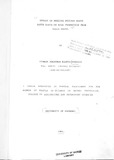| dc.description.abstract | A study was conducted to ~xamine the potential of
poultry waste as a source of nitrogen in supplemental
diets for lactating Galla goats. In Experiment I.
eighty four goats (21 per treatment) maintained on
Chloris gayana hay were supplemented for 12 weeks of
lactation with 500g (as is) of concentrate containing
0, 15, 30 and 45% poultry waste for Treatment I, II,
III and IV respectively. The poultry waste used, was
obtained from the litter after disposal of layer
pullets at the end of the laying period. The basic
litter materials (wood shavings) were sieved off
through a 1cm wire grid before feeding. The experiment
lasted for 90 days.
With an increase in the level of poultry waste
from 0 to 45% there was a corresponding increase in
the mean percent proximate composition values of ASH:
5.9 to 8.4; CF: 12.1 to 15.7 and ADF: 13.4 to 17.8 in
the four treatment diets. Values for the other
proximate compon~nts viz:- DM, OM, EE, CP and NFE were
similar.
All the concentrate diets were acceptable to the
goats without any appreciable leftovers. Voluntary
hay DM' intake was 1020.7±.31.3, 1026.0±.31.6,
1050.6~30.5 and 1069.3±.31.3 g/doe/day for Treatment I,
II, III and IV respectively, showing no significant
(P>O.05) difference among the treatments. The mean 12
week lactation yields were 680.7~62.6, 730.6~63.6,
600.7±.61.2and 673.1±.63.9 mIs/doe/day for Treatment I,
II, III and IV respectively with no significant
xxii
(P>O.05) differences among treatments.
The mean percentage values for the milk
composition in the four Treatments ranged from
13.3±O.25 and 13.9±O.26 for Total Solids; 4.2±O.14 and
4.6±O.14 for Gerber Fat; 9.1±O.22, and 9.6±O.22 for
Solid Not Fat; 3.9±O.09, and 4.1±O.09 for Total
protein and O.7±O.17 and O.8±O.17 for ASH. No
statistically significant (P)O.05) differences among
treatment means were observed. However, there was a
trend towards increasing Gerber Fat and Ash contents as
the poultry waste levels were raised in the treatment
diets.
During the study period, all the does lost weight,
in the order of 61.4±8.4, 63.9±8.9, 69.2±8.6 and
63.1±8.9 g/doe/day for Treatment I, II, III and IV
respectively, but the differences were not
statistically signif~cant (P)O.05). The respective
growth rates for the kids were 55.5±3.1, 50.6±3.4,
51.4±3.5 and 48.4±3.2 g/kid/day over the same period.
In Experiment. II twenty four goats (six per
treatment diet) were usen to determine the
digestibilities of the various nutrients of the diets
used in Experiment I. The digestibility coefficients in
the four treatment diets showed a decreasing trend from
60.3±1.5 to 55.7±1.5 for DM; 64.5±1.5 to 60.0±1.5 for
OM; 69.8±2.0 to 60.0±2.0 for EE; 67.7±3.0 to 60.7±3.0
for CP; 59.5±1.8 to 54.2±1.8 for CF and similarly
26.0±2.3 to 26.3±2.3 for ASH with increasing levels of
poultry waste in the diets but these differences
were not significant (P>O.05). Does on the different
xxiii
diets maintained similar
of 8.1±O.53, 7.6±O.53,
Nitrogen/doe/day, for
respectively.
The lack of significant differences among the
treatment means for most of the variables studied in
this work suggests that poultry waste could be used
effectively as a source of nitrogen in the diets for
lactating Galla goats, as opposed to the conventional
type of concentrate without significantly reducing
performance. | en |

